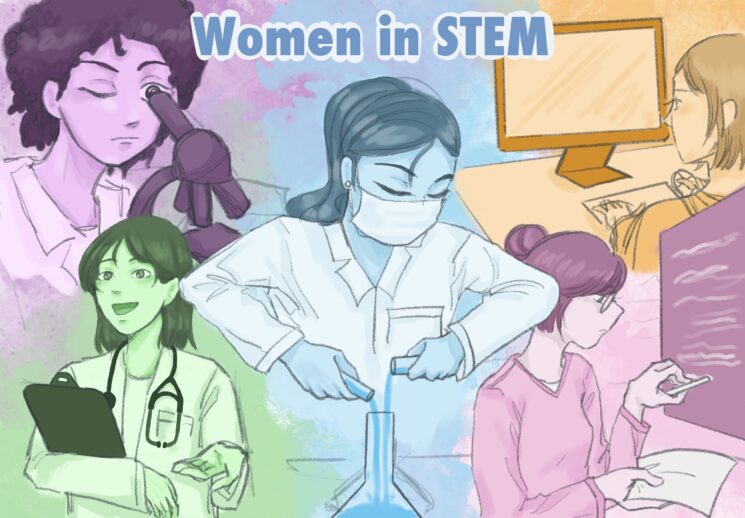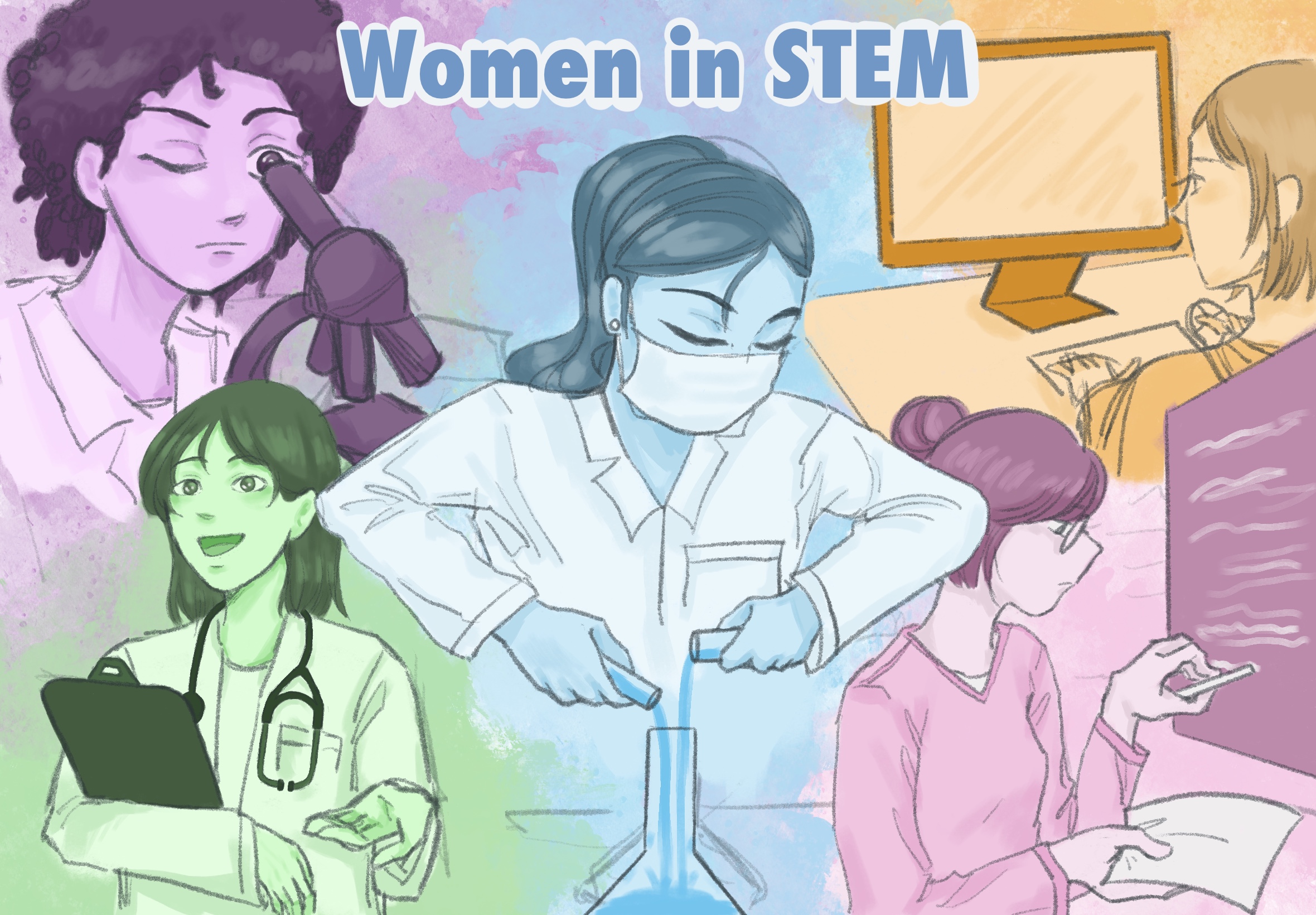
By Caroline Mora
Science, technology, engineering and mathematics (STEM). These four subjects run our world, yet women only comprise 34% of the workforce in these fields. Women are just as capable as men are when it comes to intelligence and critical thinking, so why are they so underrepresented?
Juniors Audrey Tran and Jasmine Nguyen run a website called STEAM News, where teens are encouraged to write articles about what’s happening in the science, technology, engineering, art and mathematics fields. I had the pleasure of speaking with Tran about why we need more women in STEM, and what we can do collectively to encourage young girls to take an interest in science.
Gender socialization
Gender socialization is the act of marketing toys like dolls, mini kitchens, mini cleaning sets and toy make-up to girls and trucks, legos, science experiment kits and Nerf guns to boys. Companies use marketing tactics to reinforce society’s decided gender roles for boys and girls. With the lack of STEM-inspired toys marketed towards girls, we unintentionally discourage them from chasing their STEM dreams. Girls aren’t allowed to be fascinated by computer systems, numbers, the periodic table or what an exoskeleton is because society is too busy shoving those interests down boys’ throats.
When these children grow up, the boys can find their passion amongst all of those forbidden subjects, which also happen to be monetarily lucrative, while many women never dare to show interest in Newton’s laws outside of physics class.
“I don’t think women are the minority in biological sciences, and I think that has to do with the stereotype that women are nurturers so we go towards professions like nursing. But then higher up, usually men have more advanced degrees,” Tran said.
Women hold the majority in jobs like nursing, K-8 teachers and secretaries. These are all respectable jobs, but how many of those women would have chosen a more STEM-inclusive career if they were allowed to fall in love with it? How many women would have taken their love for biology and instead used it to become a Doctor of Medicine rather than a nurse?
A culture based on bias
For centuries, male scientists have brandished their false narratives and their prejudiced science like knives to keep women out. From hurtful stereotypes like “women would rather care for a family than learn” to plain lies like “women’s brains aren’t wired for critical thinking and analyzing in the same way mens’ are”. The hippocampus, the part of the brain associated with critical learning and memorization is larger in females than males. Just saying.
However, with today’s technology, neuroscientists can see that while male and female brains do differ structurally, and structure does not inhibit function. Most differences between the male and female brain are viewed on a molecular level in tests that are associated with disease disposition or hormone secretion levels. According to Catherine S. Woolley, Ph.D., Professor of Weinberg College of Arts and Sciences and Neurology, studying sex differences in the brain is not about who’s more emotionally intelligent and who’s a better critical thinker; it’s about ensuring that biomedical research benefits all parties involved. It is about ensuring that what works for one, will also work for another.
Women have repeatedly been on the receiving end of cut corners. For example, women are more likely to be seriously injured in car crashes even though they are less likely to be involved in one. This is because the safety features are designed for the “average male body.” The car seats don’t protect women from whiplash because the designers didn’t account for women weighing less on average or average lack of muscle in the neck and upper body.
“I don’t think people should view themselves through the lens of ‘I’m a woman, it’s a little bit scary’ because you’re a person with intelligence, with a brain [and] you can go there and pursue it,” Tran said.
When women aren’t included in the research and data collection, the product will not serve them as well as it would a man. Women need to be included and represented in every relevant conversation to ensure women’s health and safety.
Underrepresented and undervalued
There’s a general lack of women role models in STEM. Of course, there are the greats, Marie Curie (The Mother of Modern Physics), Lise Meitner (The Mother of the Atomic Bomb), Chien-Shiung Wu (The First Lady of Physics) and Marie Maynard Daly (The Mother of Genetics and Heart Diseases), who are all famous for their great contributions to the fields STEM.
However, most only know one of the names listed above. While Marie Curie did win two Nobel Prizes, the rest of the aforementioned women barely received the proper recognition and credit for their research that they deserved. This makes the list of “famous” women scientists pretty short if you’re a young girl looking for a prominent role model in STEM.
If you do a little bit of research, you can find plenty of women who fought for equality in their fields in order to bring us theories that we still use today. Why do you have to do work to find information on these women? Why aren’t their names listed right next to the male scientists in their fields who used their theories as the basis for their experiments?
Historically, women have not received the same amount of recognition for their contributions as men have. They’ve been passed up for awards and due to their peers viewing them as less credible due to their gender. Not to mention, despite performing the same job, men in STEM make around $15,000 more than women do, and women of color make even less.
Despite today’s efforts to interest more young girls in STEM, one big reason a lot of them have a hard time making a connection with it is because they feel like it’s a boys club. There aren’t a lot of male nail technicians, so you don’t see a lot of young boys aspiring to work in a nail salon. The same goes for girls. If they don’t see proper representation, they won’t have a role model to inspire them. And while Marie Curie sure is inspirational, we need living examples. But who says that you can’t be your own example?
A message to the girls
Women are severely underrepresented in the fields of science, technology, engineering and math due to the complicated history between the sexes and what society thinks is a fitting job for women. There are plenty of opportunities to get out there and figure out if STEM is your calling. If you are willing to work tirelessly and oftentimes underestimated in order to yield results, this field might be for you.
It’s not always glamorous, but it’s work that needs to be done, and who better to do it than a woman? Throughout history, women have defied and exceeded society’s expectations for women, so why should we stop doing just that?
“To the girls who are scared to enter a male-dominated field [because] you don’t find role models or leaders to look towards, be your own role model. Be the one who goes into that field first. Don’t view yourself as a woman, you’re a person with a brain. You should go into that place and pursue your career,” Tran said.
Don’t let the lack of representation discourage you— you as a woman are no less intelligent and no more emotionally driven than a man is either. Don’t hyper-fixate on what you haven’t achieved; instead, focus more on what you could.





